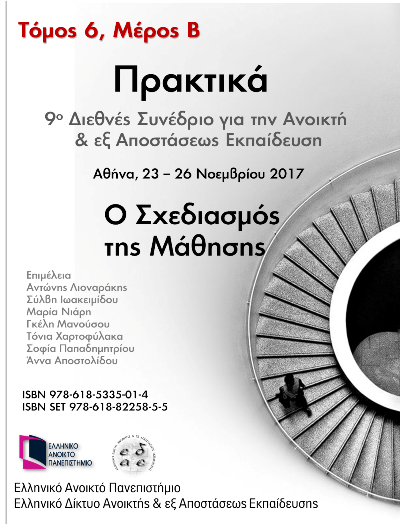Διερεύνηση της αυτο-αξιολόγησης των μαθησιακών αποτελεσμάτων της Ενότητας της ΔΜΥ 51 του ΜΠΣ Διοίκηση Μονάδων Υγείας του ΕΑΠ

Περίληψη
ΕΙΣΑΓΩΓΗ: Η αυτο-αξιολόγηση των μαθησιακών αποτελεσμάτων επελέγη ως τρόπος διερεύνησης του αντιλαμβανόμενου επιπέδου του εκπαιδευτικού έργου από τους φοιτητές της ενότητας 51 του μεταπτυχιακού προγράμματος Διοίκησης Μονάδων Υγείας του ΕΑΠ.
ΣΚΟΠΟΣ: Η διερεύνηση της αυτο-αξιολόγησης των μαθησιακών αποτελεσμάτων της ενότητας της ΔΜΥ51 του ΜΠΣ Διοίκηση Μονάδων Υγείας του ΕΑΠ και η συσχέτισή της με τα αποτελέσματα της τελικής εξέτασης.
ΜΕΘΟΔΟΛΟΓΙΑ: Το δείγμα της μελέτης αποτέλεσαν 99 ΜΠΣ φοιτητές της ενότητας ΔΜΥ51 (ποσοστό απαντητικότητας: 24%) οι οποίοι εκλύθηκαν να συμπληρώσουν επώνυμο ηλεκτρονικό ερωτηματολόγιο, το οποίο είχε σταλεί στα προσωπικά τους εμαιλ το οποίο δημιουργήθηκε για το σκοπό της μελέτης. Ελήφθησαν όλα τα απαραίτητα μέτρα για να διασφαλιστεί η εμπιστευτικότητα και μη αποκάλυψη της ταυτότητας των συμμετεχόντων. Το ερωτηματολόγιο διερευνούσε το κατά ποσό οι φοιτητές, μετά τη μελέτη και παρακολούθηση της ενότητας, ήταν σε θέση να δώσουν ορισμούς, να περιγράψουν και να καθορίσουν έννοιες που αποκτήθηκαν κατά τη διάρκεια της παρακολούθησης της ενότητας και να προσδιορίσουν τις διαφορές τους. Οι απαντήσεις δίνονταν σε 6βάθμη κλίμακα Likert, όπου το 1 αντιστοιχούσε στο “διαφωνώ απόλυτα” και το 6 στο “συμφωνώ απόλυτα”. Η ανάλυση των αποτελεσμάτων έγινε με τη χρήση του στατιστικού πακέτου SPSS 21.
ΑΠΟΤΕΛΕΣΜΑΤΑ: Οι φοιτητές αξιολόγησαν σε 100 βαθμη κλίμακα ότι έχουν κατακτήσει κατά μέσο όρο 76,93% των γνώσεων που τους προσφέρθηκαν στην ενότητα. Οι φοιτητές σε ένα πλήθος 107 ερωτήσεων αξιολόγησαν σε ποσοστά άνω του 50% ότι συμφωνούν και συμφωνούν απόλυτα ότι μετά τη μελέτη και την παρακολούθηση της ενότητας έχουν κατακτήσει τις συγκεκριμένες γνώσεις που τους προσφέρθηκαν. Κάνοντας σύγκριση των αποτελεσμάτων της αυτοαξιολογησης και της τελικής τους βαθμολογίας στις εξετάσεις διαφαίνεται ότι οι φοιτητές που αυτοαξιολογησαν χαμηλά την κατάκτηση της γνώσης στην ενότητα έλαβαν και χαμηλή βαθμολογία, ενώ οι φοιτητές που αυτο-αξιολογήθηκαν υψηλά έλαβαν και υψηλή βαθμολογία στις τελικές εξετάσεις της ενότητας.
ΣΥΜΠΕΡΑΣΜΑΤΑ: Η αυτο-αξιολόγηση είναι μια μέθοδος η οποία μπορεί να χρησιμοποιηθεί από τους φοιτητές για την αξιολόγηση των μαθησιακών αποτελεσμάτων της ενότητας καθώς και από τους καθηγητές για να συσχετίζουν τα αποτελέσματα της με αυτά της τελικής βαθμολόγησης των φοιτητών στις εξετάσεις και να το χρησιμοποιούν ως μέτρο διασφάλισης της ποιότητας του εκπαιδευτικού έργου που προσφέρεται στους φοιτητές της ενότητας κατά τη διάρκεια της ενότητας ΔΜΥ 51.
Λεπτομέρειες άρθρου
- Ενότητα
- Τμήμα Β


